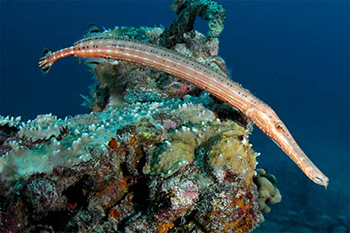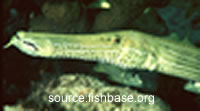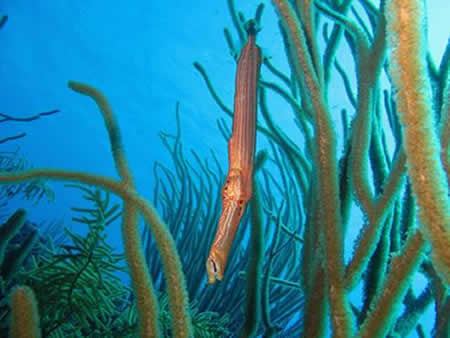Trumpetfish
Aulostomus Maculatus

Taxonomy:
Kingdom Animalia
Phylum Chordata
Class Actinopterygii
Order Syngnathiformes
Family Aulostomidae
General Description
Trumpetfish, also known as Atlantic Trumpetfish, Caribbean Trumpetfish, Corneta (in Spanish-speaking regions) and Fifer, are slender, elongate fish with a large, long head and compressed snout. Because of the shape of the fish, and the fact that some liken the fish’s mouth to the mouthpiece of a trumpet, the fish has inherited the common name “trumpetfish” (Oceana.org). At the tip of the elongated snout is a single, prominent barbell. The dorsal and anal fins of the trumpetfish are small, reduced, and set very far back on the fish’s body, lending an almost snake-like appearance. The dorsal fin is preceded by twelve dorsal spines, and the caudal (tail) fin is small and highly rounded (flmnh.ufl.edu). Size averages at just over three feet, or around one meter (oceana.org). Coloration in trumpetfish is highly variable from individual to individual and place to place, depending on location of the fish and habitat, but the three basic colorations are a reddish brown (the most common), grey-blue, and yellow-green (marinebio.org) Even within these basic themes, however, the trumpetfishes coloration is highly variable. Various patterns of irregular dark black or brown spots or blotches are common, and the fish can readily change its color to closely match its surroundings for camouflage. In most individuals, several markings including one or two dark spots on the caudal fin and black bars at the base of the dorsal and anal fins are present, regardless of camouflage pattern or color morphology (flmnh.ufl.edu). Interestingly, the trumpetfish is rarely seen swimming horizontally—instead the fish slowly swims or floats in place more or less vertically, with the head sticking down, often amongst sea whips (fishbase.org). Interestingly, aside from the cornetfish (a close trumpetfish cousin), the trumpetfish is most closely related to seahorses (marinebio.org).
Life History and Ecology

(source: fishbase)
Range and Habitat
Trumpetfish are fairly common throughout shallow waters of the Caribbean, extending from the Florida coast, throughout the West Indies, along the coast of the Gulf of Mexico, the Yucatan Peninsula, and western Central America south to northern Brazil. Isolated populations of trumpetfish are also found off St. Paul’s Rocks in the eastern Atlantic and scattered along the coast of West Africa (flmnh.ufl.edu). A close relative, the Chinese Trumpetfish, inhabits much of the west Pacific, but is a separate species.
The trumpetfish inhabits sea grass beds and coral reefs in shallow waters between 2-25 meters (6-82 feet) deep, inhabiting both fore reef and back reef zones. On reefs, trumpetfish are found particularly in and around areas abundant in vertical structures like sea whips, certain sponges, and sea fans, which lend easily to camouflaging themselves in and amongst these vertical structures (fishbase.org). Similarly, in sea grass beds, trumpetfish will swim vertically amongst the sea grass for camouflage.
Feeding Behavior
Trumpetfish are carnivores, feeding on small fish and invertebrates. While most of the fish trumpetfish eat are quite small, like gobies and blennies, they have been known to consume fish as large as smaller grunts and surgeonfish. Rather than using sheer speed or agility to catch prey, trumpetfish have developed several specialized feeding techniques. One is to camouflage themselves using their chromatophores vertically amongst sea whips or sea fans and either remain stationary or slowly drift with the current around the bases of these gorgonians. When a prey item presents itself, the fish opens its mouth wider than the diameter of its own body, facilitated by elastic mouth tissues, creating a vacuum that sucks the prey into the trumpetfishes mouth (flmnh.ufl.edu). Another specialized hunting technique involves the trumpetfish slowly swimming behind a large herbivorous fish, using the larger fish as camouflage, then coiling its body into an s-shape and rapidly lunging at prey when an opportune moment to strike presents itself. Trumpetfish seem to select a shadowing fish based on color: red-brown trumpetfish tend to shadow brownish fish like grouper, blue-grey trumpetfish shadow schools of blue fish like blue tang, and occasionally even scuba divers (oceana.org). Various larger grouper, snapper, and moray eels are known predators of trumpetfish.

Reproductive Behavior
The intricacies of trumpetfish reproduction are not well studied, but it is known that they use their chromatophore color changing abilities to conduct elaborate mating display rituals. These courtship rituals occur near the surface, then, as in their close relatives the seahorses, the burden of caring for the eggs is given to the male, who fertilizes them and carries them in a special pouch until they hatch (marinebio.org).
Camouflage Behavior
As stated previously, trumpetfish can use special chromatophore-containing pigments to change coloration to match their surroundings. Because they are extremely weak swimmers, trumpetfish heavily rely on camouflaging themselves by “standing” vertically amongst sea whips and other gorgonians for both defense from predators and in order to catch prey. Trumpetfish can even go so far as to sway back and forth while vertical to mimic the swaying of a sea whip in the current (fishbase.org).
Ecological and Economic Significance
Trumpetfish are not dangerous to humans, nor are they a particular source of food for people, although they are edible and may be marketed locally as a food fish. Also, they are becoming an ever increasingly popular aquarium fish, although it is speculative how well cared for a fish that grows to over three feet can be in a home aquarium (fishbase.org). One interesting possible ecological role the trumpetfish may play in the future is beginning to pan out in the Caribbean. The Atlantic trumpetfish’s Pacific counterparts are known to be one of the few predators of juvenile lionfish, and it is theorized that the Atlantic trumpetfish may gradually learn to predate juvenile lionfish, helping to check the numbers of this growing invasive species (oceana.org).

Recent Research
In looking for research done on the trumpetfish, I was surprised and disappointed to find nothing about the theoretical use of trumpetfish as a means of controlling lionfish populations in the Caribbean.
However, there has been some interesting research done on the trumpetfish relatively recently. In the article Foraging Behavior of the West Atlantic Trumpetfish Aulostomus Maculatus: Use of Large, Herbivorous Reef Fishes as Camouflage, Aronson quantitatively analyzes whether or not trumpetfish actually exhibit the often-described behavior of camouflaging amongst other similarly colored reef fish in order to sneak up on prey. Over a period of days, a section of reef was observed, and the position of trumpetfish noted. It was observed that, indeed trumpetfish did exhibit this behavior, but it was not nearly as common as camouflaging amongst gorgonians. Interestingly, it was found that trumpetfish of the various color morphologies by and large tended to shadow fish or schools of fish with similar coloration patterns, presumably for better camouflage (Aronson 1983).
Another interesting study, Phylogeography of the Trumpetfishes (Aulostomus): Ring Species Complex on a Global Scale, (Bowen et al, 2007), sought to gain a better understanding of the evolution of the three species of trumpetfish, the Indo-Pacific A. chinensis, the west Atlantic A. maculates (the Atlantic trumpetfish), and the east Atlantic A. strigosus. By surveying mitochondrial DNA in each species, and using the commonly accepted convention of 2% sequence divergence per million years, the group worked out that the west Atlantic species diverged from the Indo-Pacific species about 4 million years ago, when the Panama isthmus was likely flooded, and the east Atlantic species was isolated from the Indo-Pacific variety around 2 million years ago, showing that the Indo-Pacific species was the original ancestral species, and the Atlantic species are examples of ring species (Bowen et al).
Personal Interest
One of the things I remember most from snorkeling the reef in Belize ten years ago were the trumpetfish I saw. Back then, as now, I thought that the trumpetfish was a properly bizarre looking fish, so I decided I would do my web page on them so that I might learn a bit more about these oddities. While I originally picked the trumpetfish merely because they looked strange, it turns out these are very interesting and weird fish in quite a few ways, from their chameleon like ability to use chromatophores to blend in with their surroundings, to their vertical upside down swimming habits, to their complex behaviors such as camouflaging behind a similarly colored large reef fish to sneak up on prey. I was also intrigued at the possibility of “teaching” the Atlantic trumpetfish to eat invasive lionfish, as their Indo-Pacific counterparts naturally do, and was actually kind of bummed out that I couldn’t find any journal articles or anything beyond speculation.
Links of Interest
Please note that the following links may have either been removed or relocated by the webpage owners since the time this student report was created.
http://www.youtube.com/watch?v=_oG4fGrAzrI video of trumpetfish mating ritual set to cheesy generic acoustic guitar
http://www.youtube.com/watch?v=IXVh197uNZE video of a trumpetfish camouflaging itself amongst a gorgonian
Literature Cited
Please note that the following references may have either been removed or relocated by the webpage owners since the time this student report was created.
Aronson, Richard B. “Foraging Behavior of the West Atlantic Trumpetfish, Aulostomus Maculatus: Use of Large, Herbivorous Reef Fishes as Camouflage.” Bulletin of Marine Science 33.1 (1983) : 166-171.
Bester, Cathleen. FLMNH Ichthyology Department. Florida Museum of Natural History. Web. 01 June 2012.< http://www.flmnh.ufl.edu/fish/Gallery/Descript/Trumpetfish/Trumpetfish.html>.
Froese, R., and D. Pauly. "Â Valenciennes, 1841." Fishbase.org. FishBase, 2011. Web. 01 June 2012.< http://www.fishbase.org/summary/Aulostomus-maculatus.html>.
Lochmann, S E W S Alevizon. “Mechanisms of coloration of the Atlantic trumpetfish, Aulostomus maculatus.” Copeia 4 (1989) : 1072-1074. Print.
Marine Wildlife Encyclopedia. Oceana.org. Web. 01 June 2012.< http://oceana.org/en/explore/marine-wildlife/atlantic-trumpetfish>.
"Trumpetfishes, Aulostomus Maculatus." MarineBio.org. Web. 01 June 2012. <http://marinebio.org/species.asp?id=114>.